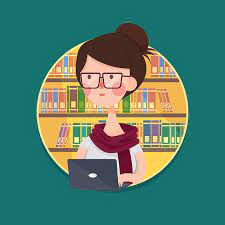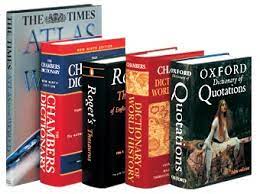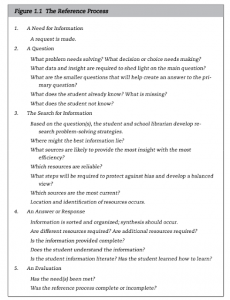Role of a Teacher Librarian
The role of a teacher librarian is all encompassing and constantly changing too. They must connect with colleagues, students and the surrounding community to curate an up to date and relevant selection of references. They do this while simultaneously guiding students through the inquiry process to help them find proper resources and ultimately help them become critical researchers. They must also also work cooperatively and collaboratively with classroom teachers in planning units and providing resources when needed as well as constantly researching resources while weeding older, irrelevant material and budgeting to add new resources into their libraries. All this can only be done with proper knowledge of the library media collection, effective communication skills as well as a strong capability to evaluate resources. I am somewhat new to my role as a teacher librarian, but I am excited (and a little overwhelmed) at how vast this position is and how I have some agency to make it my own!

Image from istock.com
What is a reference source?
Riedling states that a reference source “can be defined as materials, from book to periodical to photograph, designed to be consulted for definite items of information rather than to be examined consecutively.” (18) Thus a reference collection is the section of the library that holds all these various reference sources.
What is included in a reference collection:
– Almanacs
– Atlases
– Bibliographies
– Biographies
– Chronologies
– Dictionaries
– Digests
– Directories
– Encyclopedias
– Gazetteers
– Handbooks
– Indexes
– Pictorial Works
– Statistical Works
– Yearbooks
The above list only includes “some of the most commonly collected types of reference books”(Alderman) and even this small list makes me feel overwhelmed to say the least. Most of these references sources are not available at our learning commons (at least in a physical copy). A number of the references are new to me as I have never seen them in person or at my own school library. I have located a list that includes further descriptions of each at the following link: DigitalCommons

Image from istock.com
The Reference Process
Rielding states The three elements necessary for the reference process are the information/direction, the student, and the answer(14). Students step into the library with the goal of researching a question. As a teacher librarian it is our role to be a guide for the them, point them in the “right direction” not just “give” them the answer. Basically, to guide them in the inquiry process. Riedling states that, “The reference process may be simply explained as a problem-solving process, with the solution of the student’s problem being the goal.” (4) the following image is how Rielding describes the process:

Adding Reference Resources to your Library
Numerous funding issues coupled with the high cost of reference materials can make it difficult to maintain an entirely up to date reference section in the libaray. Not to mention, the reference section has to be weeded for out of date materials. In my opinion, this is why electronic resources are becoming more popular because the information can be kept up to date and it often requires a yearly subscription or is free!. Although I had no idea, until recently, that my school library even had access to some online resources, one of my goals for this year is to become more familiar with our electronic reference resources. I also want to get better at communicated to the school community what online resources our school has, and how to access them. Overall, when selecting a resource we need to make sure that the content is relative to our school demographic and make sure that it is coming from an unbiased accurate source. However, each reference resource had different considerations to help evaluate whether the resource should be recommended as a new addition to the libraries collection or not. One thing I noticed that in Riedling’s process rarely was cost listed as one of the main determination factors. Cost is probably the number one barrier my learning commons has when it comes to obtaining new reference materials.
In the learning commons at my school, our library webpage https://www.sd35.bc.ca/our-district/instructional-departments/digital-resources/ is connected to the district’s available reference websites. I have shown this to my students many times, even offered demo’s on how to access and use these pages but still I don’t think they are used as often as I’d like. I think students get accustomed to just searching everything with google and need more strategic lessons on other reference sources before they will access them on their own. This is something I plan on continuing doing to get students more comfortable navigating these websites and sources.
We are constantly updating our website (especially with Covid) and adding useful tips and strategies on how to access information. But again, I find unless kids are shown or taught on how to do this through a hands on lesson they tend to stick with what they know or what they have used in the past. here is a link to our webpage and the “how to” videos I helped create:
https://hdstaffordlibrary.weebly.com/researching.html
Although, I do favour “print” books for most of my students, I am finding that it is so important to teach students (especially as they get older) how to navigate the plethora of digital sources. Many of these sources are great but sometimes it takes some time to find them. I know that some librarians tend to stray away from digital reference materials because some subscriptions can really add up and take a chunk out of an already thin budget. However, the reality is digital is the way of the future and kids need strategies and skills on how to navigate them. I am always looking for new digital reference websites and apps to add to our collection. As well as, new ways to teach these skills in a fun and engaging way!
References
Alderman, Jim. “What Is a Reference Collection?” Digital Commons, University of Northern Florida, Mar. 2014, digitalcommons.unf.edu/cgi/viewcontent.cgi article=1021&context=bliss#:~:text=A%20library’s%20Reference%20Collection%20is,in%20any%20field%20of%20research.
Asselin, M., Branch, J., & Oberg, D., (Eds). Achieving information literacy: Standards for school library programs in Canada. Ottawa, ON: Canadian School Library Association & The Associatin for Teacher-Librarianship in Canada.
Digital Resources. (n.d.). Retrieved January 17, 2022, from https://www.sd35.bc.ca/our-district/instructional-departments/digital-resources/
RESEARCHING. (n.d.). Retrieved January 17, 2022, from https://hdstaffordlibrary.weebly.com/researching.html
Riedling, A. & Houston, C. (2019). Reference Skills for the School Librarian: Tools and Tips (4th ed.) [eBook edition]. Libraries Unlimited.
